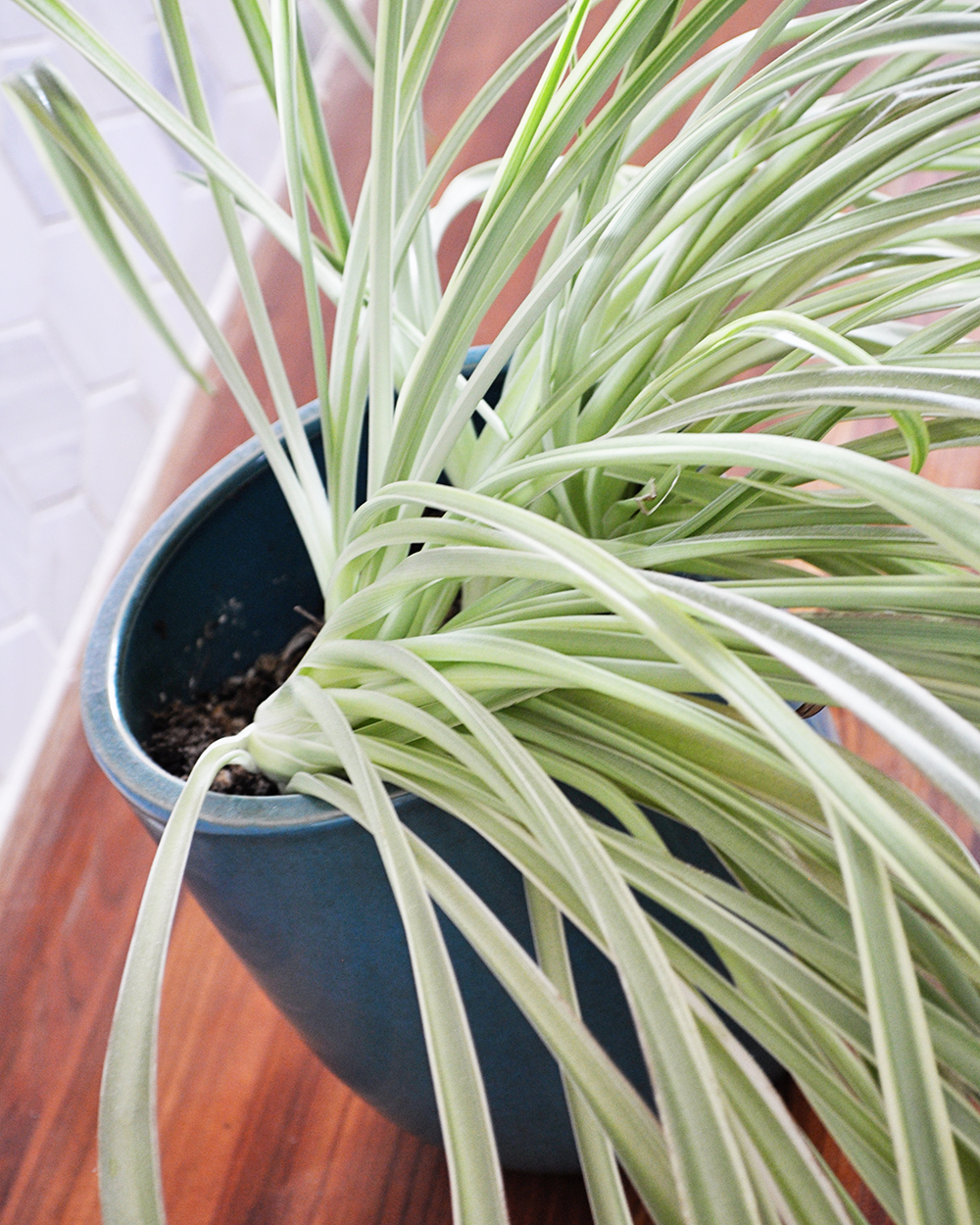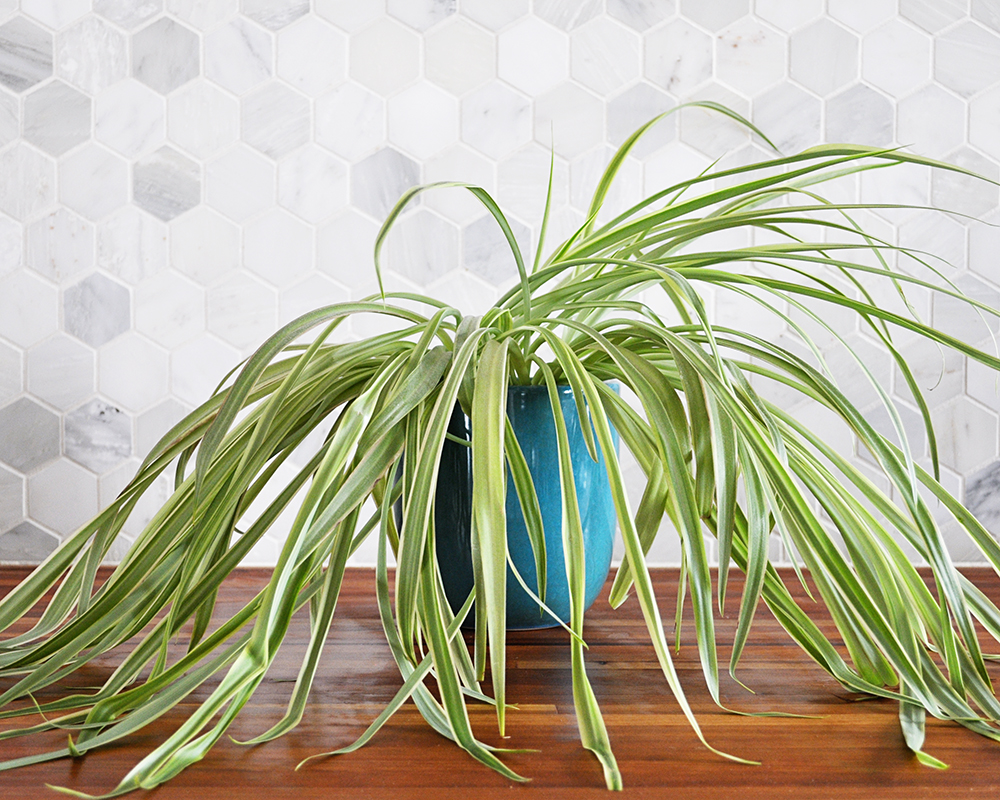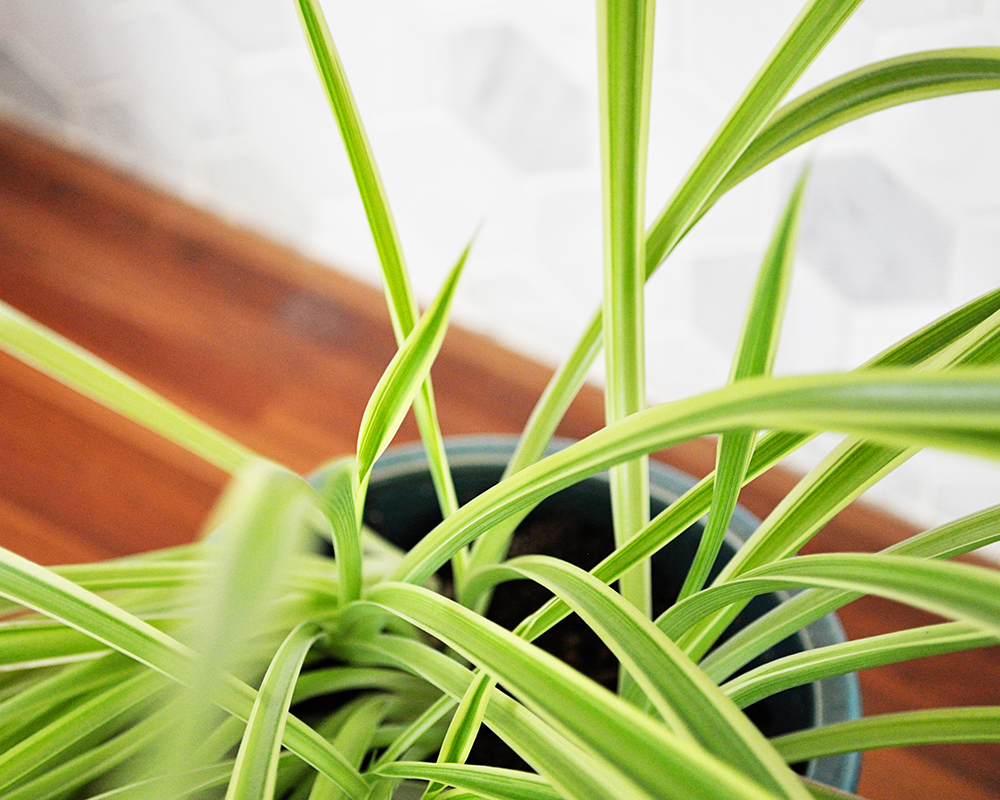It’s Houseplant Week! I absolutely love having plants in my home, but I know the thought of keeping houseplants alive can be intimidating. Trust me: I once killed a cactus. And many succulents. And a couple ferns. No judgement here. Over the years I’ve learned a few things, and now I’ve got dozens of happy plants throughout the house. If you like the idea of having some greenery in your home but aren’t sure where to start, this series is for you! Today I’m talking about spider plants.
Spider plants are AWESOME. And I say this as a person who is in no uncertain terms anti-arachnid. See, other than looking vaguely-spideresque–with all the dangly leaves like spider legs–they have nothing to do with spiders whatsoever. And thank goodness. Spiders are the worst. Spider plants, on the other hand? Two thumbs way up.
About Spider Plants:
- They look like giant spiders. Sort of. Long thin leaves grow out from the middle of the plant…like spider legs, only a whole lot more than eight. They are green with white along the edges and sometimes have paler green or white stripes down the middle of each.
- Wikipdia just taught me that they are “flowering perennial herbs.” 1) I have no idea what makes an herb an herb, but I thought that was an interesting way to classify them, and 2) I’m sure mine have flowered but I’ve always missed it! 🙁
- The flowers are small and white and a handful will grow on a single long stem. My mother-in-law’s spider plant recently flowered and it was such a lovely surprise to see when I stopped by!
- After flowering, the long stems will grow baby spider plantlets, which are adorable and I’ll tell you about in a bit.
- Like pothos and snake plants, spider plants are great at filtering formaldehyde out of the air.
- Spider plants are non-toxic to pets (yay!) but there’s a catch. Apparently they contain chemicals similar to opium that are mildly hallucinogenic to cats. So…maybe keep it out of reach if you don’t want your kitty turning into a spider plant druggie. Just saying.
When buying:
- As with other plants, always look for new growth. New leaves = healthy plant, no matter what the old leaves might look like.
- The exception to the above is when you see spotted leaves. Spots usually = disease = no bueno. Look for even green/white coloring throughout.
- If you can, find a plant with baby plantlets. That way you know it’s healthy and growing, plus you are actually getting several plants for the price of one!
- Mine is a baby from my sister-in-law’s plant, but I see them all the time in garden centers, nurseries, and even occasionally at grocery stores.
Proper care:
- Light: Bright to medium indirect sunlight is ideal. I keep mine in the kitchen, which gets the best natural light in the whole house. Spider plants are fairly bright green, except when they’re struggling. If the color of the leaves starts to fade, your plant probably might not be getting enough light. Like so:
- Water: Like pothos, spider plants will let you know when they need a drink by getting droopy.
Again, I let mine go extra long between waterings so you could really see the difference. Here’s the before:
And this is about a day after giving it two cups (ish) of water:
See how it’s both perkier and brighter green? It’s happy again!
- Soil: basic potting soil is perfect. Spider plants don’t need anything fancy.
- They grow pretty quickly and will fill whatever container you put them in. If you want a bigger plant, just put it in a bigger pot and take good care of it. Eventually it’ll be enormous. Promise.
Taking cuttings/re-potting:
- This is where I’m really sad that my plant doesn’t have any spider babies for me to show you. If you do a quick Google image search for “spider plant babies” you can see what they look like. Otherwise, just pretend my plant has a long stem coming out of the middle with a miniature spider plant on the end. To grow a new mature plant, you can snip that baby off, stick the center bit (where it was attached to the larger plant) in a cup of clean water, and let it grow roots. You can then plant it in a new pot. Free plant! Pro tip: baby spider plants make great housewarming gifts!
- When re-potting, be gentle. The leaves bend and bruise easily. Work your fingers gently through any root ball to break it up a little, then set it in your new pot and cover with potting soil. Water it well and watch it grow.
Yes, they’re slightly more temperamental and delicate than snake plants, but spider plants are great at communicating their needs. Once you know what you’re looking for, it’s so much easier to take care of them! They’re graceful and lush and a great addition to your growing houseplant collection.
Who else has a spider plant? Don’t you think the little baby plantlets are just the cutest? And what’s the verdict on Houseplant Week? Has this been helpful/interesting? Comment and question away!









I love Spider plants, they are the only indoor one that I can seem to grow, maybe its because it doesn’t need alot of looking after, I forget to water them 🙁